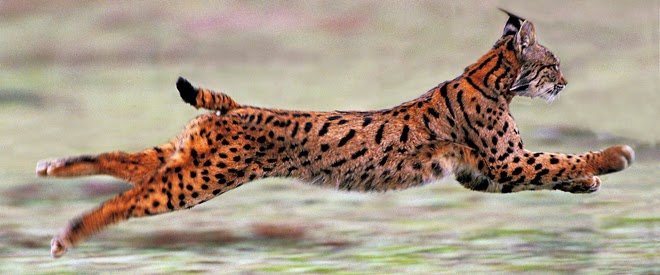Sunday, August 31, 2014
Lest we forget...2010, catastrophe in the Gulf.
On April 22, the rig collapsed causing the worst spill in U.S. history (and maybe the world's).
Despite all the attempts to stop the mile-long pipeline, oil inundated delicate wetlands, smothering plants and wildlife.
Beaches closed and fishing grounds were shut down.
The environmental, economic and political repercussions spread well beyond the oil-slicked surface of the Gulf...
Saturday, August 30, 2014
The journey of Sky, Amber and Scout: Disney Nature's "Bears".
Friday, August 29, 2014
INDONESIA: deforestation champion.
Wednesday, August 27, 2014
The Iberian lynx.
According to the organization SOS Lynx if it went extinct it would be the first extinction after the one of Smilodon 10000 years ago (indeed it is not a subspecies of the European lynx but a species in its own right).
It is 85-110 cm long and 60-70 cm tall and weighs about 13 kilos. It eats rodents, birds, amphibians and small reptiles; its biggest prey is the hare. It lives in territories of approximatley 10-20 square kilometres.
Up to the half of the 19th century it was present in almost all the Iberian Peninsula. Nowadays there are only two small zones left in Andalusia, in southern Spain. In 2005 less than 100 specimens were counted, while in 2000 they were more or less 400 and in 1960 they were 4000.
The only zones in which they live now are Doñana National Park and Andujar Sierra.
The reasons for the disapperance of the Iberian lynx are the destruction of its habitat, voluntary or accidental poisonings, car accidents, wild dogs, poaching and the lack of preys.
Luckily, there are good news. In 2005, precisely on the 29th of March, there was the first birth in captivity. In the two zones populated by the lynx, great efforts have been made and this species is on the road to recovery. In 2008 in the Andujar zone the maximum capacity was reached (150 speecimens).
Now it is estimated that from here each year approximately 20 specimens are taken to be reintroduced in other zones.
(Thanks to Lorenzo S. for helping me writing this post)
Tuesday, August 26, 2014
Floating nuclear power plants in the Arctic...Imminent catastrophe.
This power plant is composed of 2 mini reactors of 35 megawatts, mounted on a platform which can be transported offshore. Indeed, the designers created this all to be able to transport it in the remotest regions of the Arctic Ocean.
As if this were not enough, this power plant is going to be used to give energy to the drills of the Arctic oil platforms. The manifacturer said that other floating nuclear power plants of 1000 megawatts to be moored off the cost of Siberia are in planning, to produce energy that, through submarine cables, will be brought to the mainland.
The power plants are using the Arctic marine water for the cooling.
If something went wrong (which is very likely) an intervention in those seas would be almost impossible, while the destruction of the extremely fragile Arctic environment would be granted...and an enormous, shocking tragedy would be about to fall upon us all.
(Thanks to Lorenzo S. for helping me writing this post)
Friday, August 1, 2014
82 years ago...the extinction of the Schomburgk's deer.
The Schomburgk's deer was anhelpc species which lived in Thailand. It lived in herds composed of 6-10 specimens in the low-lying and marshy areas of south-eastern Asia.
Its main characteristic were the long, tapered paws, totally different from every other American, European and Asian deer. Those paws were perfect to move in the unstable marshes in which it usually grazed the newly grown grass and shrubs.
Unfortunately, this beautiful animal was a victim of the industrial and demographic growth of its country: the rapid rise of rice request to feed an always greater population led to a total and indiscriminate reclamation of wetlands to be converted into rice fields.
As if that was not enough, the hunting of this animal exploded, to give meat to the workers who we're destroying its habitat.
The last Schomburgk's deer was probably killed on the 1st of August of 1932.







